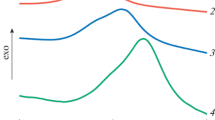Abstract
A new route to the synthesis of statistical networks similar to vulcanized rubber, from 1,2-polybutadiene (PBD) and 3,4-polyisoprene (PI) is described. The two antagonist chemical functions are both present on the polydiene backbone. The latter could be used as precursor polymer and as difunctional crosslinker simultaneously; the reactive groups are respectively the dimethylhydrogenosilane end groups and the pendent double bonds along the polydiene backbone.
Similar content being viewed by others
References
G. Greber, A. Balciunas, Makromol.Chem. 69, 193 (1963)
L.J. Bellamy, “The Infrared Spectra of Complex Molecules” Ed. Methuen and Co. Ltd London (1958)
P. Weiss, G. Hild, J. Herz, P. Rempp, Makromol.Chem. 135, 249 (1970)
French Patent, N∘ 82.19745 (25.11.1982) ATO Chimie: G. Friedmann, J. Brossas
G. Friedmann, J. HERZ, J. Brossas, Polym. Bull. 6(5), 251 (1982)
Author information
Authors and Affiliations
Rights and permissions
About this article
Cite this article
Friedmann, G., Brossas, J. 2. Synthesis of statistical networks from liquid telechelic dimethylhydrogenosilane polydiene. Polymer Bulletin 10, 28–30 (1983). https://doi.org/10.1007/BF00263234
Accepted:
Issue Date:
DOI: https://doi.org/10.1007/BF00263234




